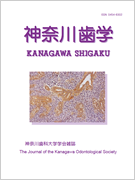- HOME
- > 一般の方
- > バックナンバー:神奈川歯学
- > 58巻2号
- > アブストラクト
アブストラクト(58巻2号:神奈川歯学)

English
| Title : | Comparison of the maxillary sinus size of adult Korean individuals with different skeletal patterns using cone-beam computed tomography |
|---|---|
| Subtitle : | ORIGINAL ARTICLE |
| Authors : | Chieko MITSUDA1), Masahiro TAKAHASHI1), Yong-il KIM2), Mayuko TAKEDA1), Reina HATANAKA1), Takehiko SAMBE3), Tetsutaro YAMAGUCHI1) |
| Authors(kana) : | |
| Organization : | 1)Department of Orthodontics, Kanagawa Dental University, 2)Department of Orthodontics, Pusan National University Dental Hospital, 3)Department of Pharmacology, Division of Clinical Pharmacology, School of Medicine, Showa University |
| Journal : | Kanagawa Shigaku |
| Volume : | 58 |
| Number : | 2 |
| Page : | 99-104 |
| Year/Month : | 2023 / 12 |
| Article : | Original article |
| Publisher : | Kanagawa Odontological Society |
| Abstract : | [Abstract] Objectives: This study aimed to examine the relationship between the maxillary sinus size and different skeletal patterns in adult Korean individuals using cone-beam computed tomography (CBCT). Materials and Methods: We enrolled 56 adult Korean individuals (mean age, 26.04 +- 6.58 years; 21 males, 35 females) and classified them into three antero-posterior skeletal patterns (skeletal Class I, Class II, and Class III) according to the A point-nasion-B point angle (ANB) - Class I (-1°<- ANB < 4°), Class II (ANB >- 4°), and Class III (ANB < -1°) - and three vertical skeletal patterns (hypodivergent, normodivergent, and hyperdivergent) according to the mandibular plane angle (MP) - hypodivergent (MP <- 23°), normodivergent (23°< MP < 30°), and hyperdivergent (MP >- 30°) as measured through CBCT images. The maxillary sinus width and depth were measured using a measurement template and automated processing with reference to the methods reported in previous studies. Differences in the size of the maxillary sinus (maxillary sinus width and depth) among the different skeletal patterns (three anteroposterior skeletal patterns and three vertical skeletal patterns) were statistically analyzed using one-way analysis of variance with the post-hoc Tukey test. Results: There were no statistically significant differences in the maxillary sinus width and depth among the anteroposterior skeletal patterns. However, a statistically significant difference (P < 0.05) in the maxillary sinus width was observed among the vertical skeletal patterns. In the vertical skeletal patterns, the mean maxillary sinus width increased as follows: normodivergent, hypodivergent, and hyperdivergent. Conclusions: Our results indicate that the vertical skeletal patterns of adult Korean individuals might be associated with the maxillary sinus width. |
| Practice : | Dentistry |
| Keywords : | maxillary sinus, skeletal pattern, cone-beam computed tomography |
